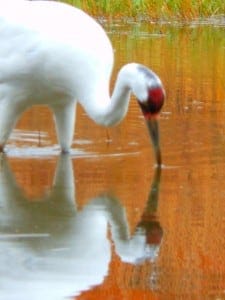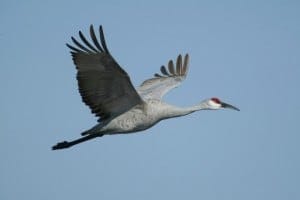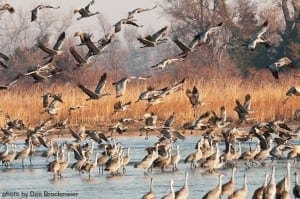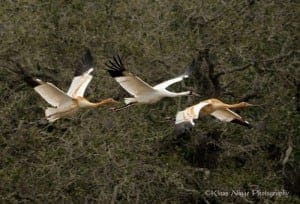As the migration of waterfowl commences, I am reminded of the plight of the cranes. Have you ever seen a group of sandhill cranes flying above you? If not, you are definitely missing out on one of the great nature experiences.
Sandhill cranes are tall birds that fly from Canada to the Southern US in the fall. They are quite abundant in their range and many people have the opportunity to see them on a fairly regular basis. My first experience hearing and seeing them was a cold December day when I was living in Milford, Ohio. They flew over and having never heard that sound before I was awestruck. My mentor explained what they were and I later learned more about them. The most amazing experience I have had in regard to the sandhill cranes took place at Jasper-Pulaski Fish and Wildlife Area near Medaryville, Indiana. Sandhill cranes gather in groups in the thousands. The last count taken this year estimated 7,010 on October 29. I was there about three years ago and witnessed this mass gathering. The noise and activity was awesome.
Sandhill cranes are a bird that you have a pretty good chance of seeing if you are in the right place at the right time. Unfortunately they do not use the Mississippi Flyway like many migrating waterfowl do. If you want to see sandhill cranes you will have to drive east to Jasper-Pulaski, or go west to the most famous gathering in the Platte River Valley in Nebraska. Patti and I saw them while driving by some corn fields outside of Madison, Wisconsin. The crane that you probably won’t see, even though they are larger than a sandhill, is a whooping crane.

Female whooping crane (photo: Savingcranes.org)
The whooping crane is the tallest bird in North America. It has bright white plumage, a red cap and black wingtips. It is similar to the sandhill crane in many ways but whooping cranes are endangered. Their numbers dropped to around 20 in the 1940s; but through captive breeding, wetland management and teaching the hand-reared cranes how to migrate, the numbers have risen to about 600.
Both of our crane species require shallow wetland areas for breeding and feeding. They also feed in large open grassland areas. They can be found feeding in crop fields as well. Both species are tall, graceful and have a mating ritual that involves dancing. Dancing is probably what cranes are best known for all over the world. They both also have a loud bugling call that resonates over larges areas.
More information about the whooping crane can be found at the International Crane Foundation (www.savingcranes.org). They are dedicated to the study and conservation of all crane species. At their center in Baraboo, Wisconsin, they raised and breed all 15 species. They are open to visitors, if you would like to go see the cranes. Patti and I were able to visit when we were in Wisconsin for a conference. This was Patti’s first exposure to cranes and now she is hooked. We were able to see a mated pair of whooping cranes up close. They are beautiful, graceful, awe-inspiring birds.
Going to the Platte River Valley to experience hundreds of thousands of sandhill cranes in one area is definitely on my bucket list. I hope you will have a chance to experience cranes in their natural habitat one day too.
Ramona Puskar
Education Assistant




Leave A Comment